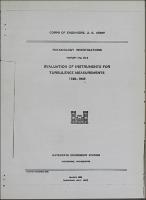Please use this identifier to cite or link to this item:
https://hdl.handle.net/11681/3114Full metadata record
| DC Field | Value | Language |
|---|---|---|
| dc.contributor | United States. Mississippi River Commission | - |
| dc.contributor.author | U.S. Army Engineer Waterways Experiment Station | - |
| dc.date.accessioned | 2016-03-16T14:45:40Z | - |
| dc.date.available | 2016-03-16T14:45:40Z | - |
| dc.date.issued | 1951-03 | - |
| dc.identifier.uri | http://hdl.handle.net/11681/3114 | - |
| dc.description | Potamology Report | - |
| dc.description | Introduction: Introduction: For basic information concerning the instrumentation for Potamology Investigations reference may be made to a Waterways Experiment Station report entitled “Preliminary Development of Instruments for the Measurement of Hydraulic Forces Acting in a Turbulent Stream”, dated June 1948, which describes the instruments and their installation in the Mississippi River at Reid Bedford Bend. The instruments were installed during the low-water season of 1947 with the intent of taking data during the entire high-water season of 1948. During the 1948 high-water season tests showed that the insulation values of the various instruments were exceedingly low, obviously because of insufficient waterproofing. Following the high-water season the instruments were removed and examined to determine factors contributing to improper operation. Upon inspection of the top bellows chambers of the pressure cells it was found that fine sand had packed around the bellows, thus preventing their proper movement. Inspection of the mat movement indicator revealed that the instrument itself as well as the electrical insulation had been damaged by flotsam and the moving parts had become packed with very fine sand. The low insulation values noted during the test period were indicative of the difficulties involved in proper waterproofing of equipment for long periods of submergence. Freezing of the pressure cells by infiltration of fine sands indicated the necessity of further protection of the cells from materials in suspension. Physical damage to equipment indicated the hazards involved in tests of this type. As a result of the experience gained from the 1948 high-water installation necessary improvements were incorporated in the design and operation of the instruments used in the 1948-49 Potamology Investigations. The 1948-1949 Potamology Investigation program required that the instrumentation branch provide instruments to measure and record hydrodynamic pressure variations, pressure differentials, velocities, and vertical mat motion. The instruments involved in making the above measurements were pressure variation cells designs 5 and 7, differential pressure cells design 6, Price type velocity meters and WES pressure cell velocity motor, and the mat movement indicator, respectively. | - |
| dc.publisher | U.S. Army Engineer Waterways Experiment Station. | - |
| dc.publisher | Engineer Research and Development Center (U.S.) | - |
| dc.relation | http://acwc.sdp.sirsi.net/client/en_US/search/asset/1031280 | - |
| dc.relation.ispartofseries | Potamology investigations report ; no. 10-3. | - |
| dc.rights | Approved for public release; distribution is unlimited. | - |
| dc.source | This Digital Resource was created from scans of the Print Resource | - |
| dc.subject | Potamology | - |
| dc.subject | Mississippi River | - |
| dc.subject | Instruments | - |
| dc.subject | Equipment | - |
| dc.subject | Hydraulic forces | - |
| dc.subject | Hydraulics | - |
| dc.subject | Turbulence | - |
| dc.subject | Measurements | - |
| dc.title | Evaluation of instruments for turbulence measurements, 1948-1949 | - |
| dc.type | Report | en_US |
| Appears in Collections: | Potamology Investigations Report | |
Files in This Item:
| File | Description | Size | Format | |
|---|---|---|---|---|
| Potamology-Investigations-Report-No-10-3.pdf | 10.41 MB | Adobe PDF |  View/Open |